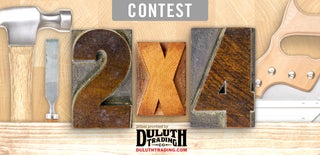Introduction: A Photographic Guide to Selecting Lumber
If you have spent any time in the lumber section of a home center, you have probably seen people digging through piles of 2x4s, pulling out one at a time, and peering down its length to determine its quality. With this instructable I hope to save you time while also helping you select the best wood for any project. All of the information used here can be found in Wood Handbook: Wood as an Engineering Material published by the USDA, which can be freely accessed here. I will attempt to pare down this 500+ page book into a brief, but useful, instructable for selecting wood.
Note: while most pictures herein depict cedar, these rules apply to any wood. I chose to use cedar for two reasons: first, its characteristics are usually well defined, making it a good sample for this photographic guide, and second, the stock of cedar at the store had the best lighting for taking pictures.
Please note, you have to click on the individual pictures to see all the notations! Also if you like this please vote in the 2x4 and epilogue laser contests! Thanks!
Step 1: Things to Avoid
The Pith:
The pith is the center of a tree, easy to spot by looking at the base of a 2x4 for a) a full circle or b) a tightly curved grain, indicating that lumber was cut close to the tree's center. The pith is very hard and brittle, prime conditions for cracks to form.
Sapwood:
Sapwood is the outermost few growth rings of the tree, and depending on the type of wood this can be difficult to identify. It tends to be easier to spot in darker woods, but can be difficult in lighter wood like pine.
This wood is softer and weaker than pith or heartwood, and rots more quickly than either if wet. While Sapwood's increased malleability is a potentially positive attribute, it should generally be avoided for most projects.
Changes in ring direction:
This is not always bad, in facts sometimes this can lead to interesting grain in the board, however it can also potentially lead to twisting in the board, however if you are looking for a purely structural board and don't care about how it looks I would avoid boards with different rings orientations.
Avoiding these things should result in you easily finding fairly straight boards.
Step 2: Things to Look for
Heartwood is simply wood that does not contain the pith or sapwood. It is the strongest and most stable part of the tree and boards made of heartwood can be milled in one of the three following ways:
Flat-Sawn:
This is the most common type you will find, characterized by the rings being anywhere from perfectly horizontal up to 30º from horizontal. These boards look like what you imagine a typical wood board to look like, and should remain fairly flat. Flat-sawn wood may cup a little bit but it should be minor.
Rift-Sawn:
Rift-sawn wood is any piece in which the rings are at about a 45º angle from horizontal (30º to 60º is considered rift sawn). Again as long as this is heart wood this should remain fairly flat. Visually the grain of a rift-sawn board is very straight, depending on the look you are going for this can be very desirable.
Quarter-Sawn:
Quarter-sawn boards are ones with vertical rings (or 60º to 90º). These boards are the most stable, this is because wood expands more with the rings than it does across them*, this makes these boards ideal if you are planning on gluing multiple of these boards together. Visually quarter-sawn wood can be very attractive. For some woods quarter-sawn doesn't have a distinct appearance but woods like white oak are prized for their appearance when quarter-sawn.
*A more full description of wood expansion can be found starting on page 84 of the linked pdf along with specific expansion rates for different species of woods.
Following the rules in step 1 should get you fairly straight and flat boards, adding the rules in this step should give you the exact board you want.

Participated in the
Full Spectrum Laser Contest 2016

Participated in the
2x4 Contest













